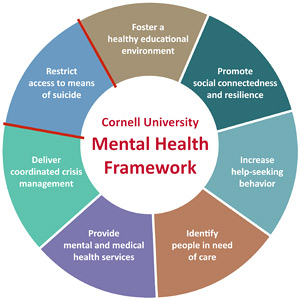Experts spell out the importance of bridge barriers in preventing suicides
By Susan Kelley

Ithaca's unique gorges require a unique solution to the problem of bridge safety, according to suicide-prevention expert Eric Caine '69, chair of the department of psychiatry at the University of Rochester Medical Center and a consultant to Cornell. That solution, he believes, must include "means restriction" on bridges, such as barriers or nets.
"This is the one place that we know of, in the country if not the world, where nearly half the suicides are related to jumping off bridges -- not just one iconic bridge, but the bridges in the community," he said, referring to suicides among Cornell students. Given the high proportion of jumping deaths, means restriction on bridges is likely to reduce the overall number of suicides, he said during forums April 4 in Malott Hall and at St. Paul's Methodist Church in downtown Ithaca.
Caine and three other panelists spoke on the rationale for permanent barriers, which Cornell and the city of Ithaca are studying. Tim Marchell, director of Mental Health Initiatives at Cornell's Gannett Health Services, facilitated the forums. About 35 students, staff, faculty and community members attended each.
Research shows that bridge barriers in other parts of the world have stopped suicides, Caine said. "It's very clear, over and over again, that when you put up a barrier on a bridge, suicides there are almost completely stopped." He added that it is important to treat the campus area bridges as a whole, because while most suicidal individuals deterred from jumping will not do so elsewhere, the risk increases if there are comparable bridges nearby.
It is vital that the potential impact of bridge barriers on the natural environment be addressed, said panelist and environmental psychologist Nancy Wells. An associate professor of design and environmental analysis, Wells is also a member of the City of Ithaca/Cornell University Means Restriction Study Committee, which has been meeting since last fall to explore issues and inform design concepts for potential safety structures.

Research shows that views of and access to the outdoors increases cognitive functioning and the ability to cope in the face of stress, Wells said. That's one of several reasons why the committee is working to strike a balance between preventing suicides and preserving the gorges' natural beauty, she said. For some people the memory or knowledge of deaths near the gorges can overshadow the outdoor experience, she said. "Ultimately our hope is that ... by reducing the number of jumping deaths that do occur, that people will have more consistently positive associations with these vistas."
Gorge deaths can have a profound, even traumatizing, effect on people who witness someone jump or observe a body recovery, added panelist Lee-Ellen Marvin, executive director of the Suicide Prevention and Crisis Service of Tompkins County. She described how two community members who witnessed a woman jump to her death had been unable to cross the campus area bridges for years until the current temporary barriers were put in place, providing them with a sense of security.
Bridge barriers have been the missing piece in Cornell's comprehensive public health approach to mental health and suicide prevention, said panelist Gregory Eells, director of Gannett's Counseling and Psychological Services. "Many of the students that we see say they feel much safer having those barriers there."
Cornell restricts access to lethal means:
Cornell promotes the mental health of its students by caring for the whole person, with a comprehensive public health approach that takes its cues from the best practices in the field.
That approach includes restricting access to lethal means of suicide. The university forbids possession of firearms and other weapons or dangerous substances, secures access to dangerous chemicals and equipment and has installed temporary fences on high gorge bridges on and near campus.
During the question period at one of the forums, an audience member asked about a suicidal individual who climbed around a temporary barrier and nearly jumped. Marvin responded that the barrier worked, by slowing the person down and allowing concerned bystanders and eventually rescue personnel to persuade the person to come to safety.
That's an important consideration, Caine added, because individuals who survive a suicide attempt usually were ambivalent about their attempt and are unlikely to try again. "Most people who attempt suicide once go on to live, and [they] die from other causes, such as heart disease, cancer, automobile accidents," Caine said. "… Be very, very clear: most people who attempt once do not die by suicide. That's unequivocal data."
Architects are continuing to develop design concepts for barriers on each bridge. By the end of May, Cornell expects to file a site plan review application with the city of Ithaca.
Media Contact
Get Cornell news delivered right to your inbox.
Subscribe